Following is a step-by-step guide for how to remove pet urine and pet urine stains from flooring and furniture. This guide focuses mostly on non-toxic products to help you completely remove the pet urine odor, which prevents recurring problems. These products have been found by pet owners to work better than Resolve stain remover, carpet deodorizing powder formulated for pets, and enzyme-based products found in pet stores that discourage urinating in specific areas.
Carpet and Furniture
Carpet and Furniture pose the most tricky scenarios for completely removing pet urine. The trick is to be thorough and persistent–and to use products that remove odors rather than masking them with other scents.
Citra-Solv (you can get it here from Amazon) is a 100% natural concentrated cleaning solution made from oranges. It contains D-limonene, a clear fluid derived from orange peels, plus orange oil and biodegradable cleaning agents extracted from coconut oil.
Citra-Solve is available in health food stores, online, and you can even find it in many regular grocery stores. It’s safe on carpet, upholstery, wood, tile, linoleum, and most surfaces. However, you need to spot test it on an inconspicuous area first to make sure that your carpet or furniture upholstery is colorfast.
Essential oils derived from citrus fruits and herbaceous plants change the molecular structure of odors, rather than just masking them–unlike most other deodorizers on the market. This is very important when it comes to a dog’s nose. Dogs have a sense of smell 700 times stronger than that of humans. If you’re using a product that simply masks odors, Fido is still going to smell that urine and be tempted to pee in what he thinks is an acceptable area.

Borax, also known as 20 Mule Team Borax, is available in the laundry section of most grocery stores and discount retailers. It’s completely natural. It’s used most often for to boost the power of laundry detergent, especially for white clothing. But it can also be used as a natural and effective household cleanser. Borax also works well on urine-soaked or stained mattresses.
Here’s how to remove pet urine and pet urine stains from carpet or furniture upholstery:
If the urine spot is fresh, soak up as much urine as possible with a large absorbent rag. Use a lot of pressure, applying as much of your body weight as possible. If the urine spot is on the floor, stand on the rag. If the rag becomes saturated, use as many additional rags as necessary until you’re no longer absorbing any liquid. Even if the area seems already dry, employ this method, especially on furniture; the moisture will likely have penetrated to deeper areas. Place the rags in a small bucket.
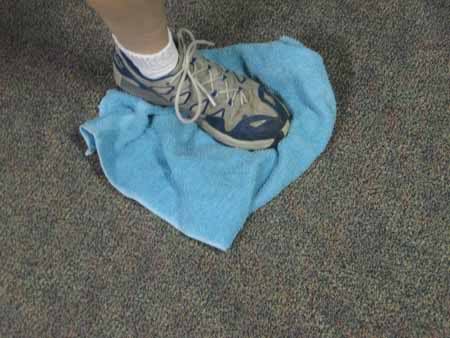
With another clean rag, place several spots of undiluted CitraSolve on the rag. Rub it deeply into the entire affected area, scrubbing briskly. Apply more CitraSolve on new areas of the rag if necessary. Place the rag in the bucket.
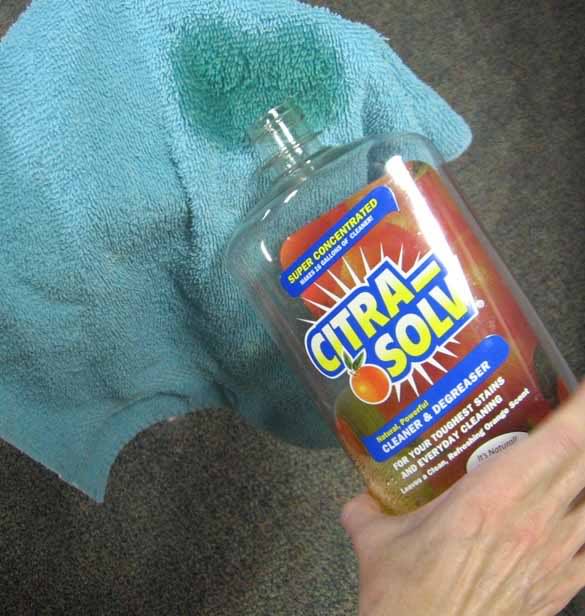
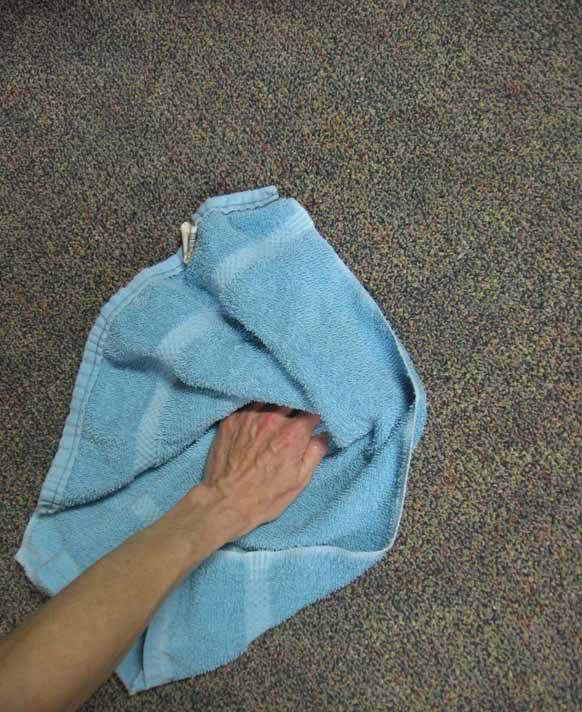
Now sprinkle Borax over the area. Borax is unscented. It absorbs odors rather than merely masking them. Therefore, your carpet or upholstery won’t smell like pet urine mixed with flowery scented carpet deodorizer powder. Let the area dry for several hours. When the Borax is completely dry, you can vacuum it.
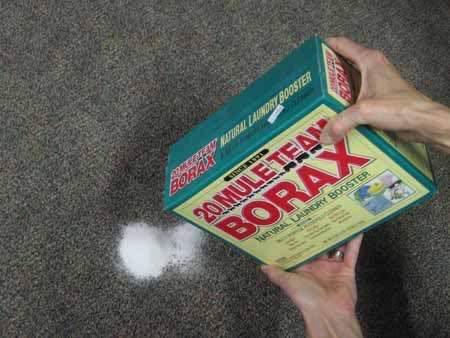
If you’re removing cat urine, you can place some undiluted vinegar in a spray bottle and place it near the area. Cats hate the smell of vinegar. To be even more effective, you can spray some of the vinegar on a small rag and drape the rag over the bottle. And if you use a spray bottle filled with water for discipline, the spray bottle also works as a visual deterrent. But don’t use vinegar in a spray bottle to discipline your cat, as it might accidentally get into his or her eyes and cause serious irritation!
Now you should immediately wash all the rags you used. If you leave them lying around, the animal will smell the urine and think that the vicinity is an acceptable place to urinate. For example, you might have an old bucket in your utility area that you throw rags into until you have enough for a load of laundry. But that won’t work with urine-soaked rags! They must be washed immediately. Wash them in hot water with the usual amount of laundry detergent, and add approximately ¼ cup of Borax to the wash.
Block the area from your pet’s access with empty cardboard boxes or pieces of furniture for a couple of days. This will keep them away from any temporary residual moisture from the cleanup process, plus alter their traffic pattern–both of which will prevent your pet from getting any bad ideas.
If for some reason your pet’s urination on carpet becomes a chronic problem, you might consider taking up the carpet and replacing it with hard-surface flooring. Once you remove the carpet, if you find a urine stain on underlying hardwood floor, you can sand the entire floor in that room. You can rent a sander from a local home improvement retailer, or you can hire a professional. Focus particular effort on the stained area to completely sand the stain out of the wood grain. Then you can apply a protective coat of polyurethane.
If your underlying flooring is basic particle board, you can apply Kilz paint before adding your new flooring atop the particle board. This paint is available at home improvement retailers. It kills mildew and pet urine odors. Your pet won’t be tempted to urinate in the same spot when your new flooring is in place. Apply the paint directly on the particle board in the affected area. Better yet, apply it in a larger circumference than the affected area, just to be safe! Let it dry overnight before installing new flooring.
Hard Surfaces
Hard surfaces include flooring of all types: hardwood floors, tile, lineoleum, pergo and concrete. It may even include surfaces such as a formica countertop, depending on whether your pet has urinated in an unusual spot!
Absorb all the urine with rags. Use as many rags as necessary. Place them in a small bucket.
Use a rag dampened in diluted CitraSolve to clean the area. Place one capful of Citrasolve in a small bucket, then fill the bucket with warm water. You should spot check the CitraSolve solution in an inconspicuous area first to test for colorfastness. If you’re working on a hardword floor, be sure to wring out all the excess water to prevent floor damage. The CitraSolve will completely eliminate the odor, which will deter pets from urinating in the same area again. If you prefer to use undiluted CitraSolve, that’s fine; just be sure to test for colorfastness first, and wipe the area with a damp rag afterward.
Wipe the area dry with a clean, dry rag. If it’s a hardwood floor, be extra sure to absorb all moisture. Please note that it’s unnecessary to use Borax on hard surfaces; also, the granules might scratch hardwood floors.
Wash the rags immediately in hot water with laundry detergent and approximately ¼ cup of Borax.
Block the area from your pet’s access with empty cardboard boxes or furniture items for a couple of days. This will keep them away from any temporary residual moisture, plus alter their roaming habits.
If you’re dealing with cat urine on a surface where you don’t mind potential moisture marks, such as on concrete in a basement utility area, you can pour a small puddle of vinegar over the cleaned area. Rub it in, making a large circle, then wipe up the excess. The vinegar odor will deter cats from urinating in the same spot again. You may also want to use the vinegar spray bottle visual deterrent trick, complete with a vinegar-sprayed rag draped over the bottle.


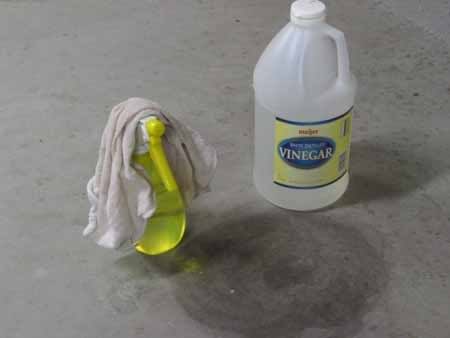
You may also consider having your carpets and furniture professionally cleaned. Alternatively, you can rent or purchase carpet cleaners.
How to stop/prevent your cat from peeing outside the litter box
If you’re continuously having trouble with your cat urinating outside its litter box, a resource I highly recommend you check out (especially if you’ve tried other methods to no avail) is something a friend of mine put together on the subject–she spent over $2700 replacing furniture her cat peed on and tried everything she could think of to solve the problem–through trial and error she finally ended up figuring out what worked and what didn’t. She has just recently put together a guide based on her experience to help other who are suffering from the same dilemma, I highly recommend that you pick it up: 18 Ways to Stop Cat Urine Odor Problems.
Other Helpful Hints
It’s fairly uncommon for cats to urinate outside the litter box unless it’s a medical problem. As soon as your cat urinates somewhere outside the litter box, you should make an appointment with the veterinarian to be sure that your cat doesn’t have a urinary tract infection or urinary tract blockage. Their urine can crystallize in the urinary tract due to pH levels in food. This is a fairly common ailment for cats.
Another common ailment for very old cats is failing kidneys. If your cat has failing kidneys or a urinary tract infection, no trick you use to remove urine stains and odors is going to stop him or her from urinating outside the litter box. The cat is either in pain, and is trying to tell you, or either it literally has no control over its bladder. Also, older cats may simply be incoherent and just want to urinate anywhere that’s soft.
Sometimes, though it’s relatively uncommon, cats pee outside the litter box for behavioral reasons. This can happen when you have more than one male cat in a household, in particular. It’s more common for males to urinate outside the litterbox than females. That’s because they’re marking territory. If you have more than one cat, you may consider having only one male cat in the bunch.
Puppies, unlike kittens, are far more difficult to potty train. Once you place a kitten in the litter box, it knows where to urinate from that time forward. But puppies require frequent, repetitive and identical training for several weeks. Puppy potty training is most effective if it also involves keeping the puppy in a large cage at night or during unattended times, as puppies will instinctively avoid soiling their own area.
As for adult dogs, make sure you walk your dog frequently enough. Would you want to hold the urge for more than eight hours while someone was away at work? Train your dog to use a newspaper if you’re going to be gone for a long period of time. Better yet, hire a trusted neighbor or pet sitter to walk your dog while you’re away. Dogs should go potty very first thing in the morning–as soon as you have, of course!–plus mid-day, after dinner and definitely right before bedtime, at the absolute minimum.
Regardless of whether you have a dog or cat, don’t rub your pet’s nose in the urine after the fact. This is very confusing and upsetting for your pet. But if you catch your pet in the act, make a very loud noise such as yelling “No!” repeatedly and clapping your hands. Also using a squirt bottle of water works well with cats; they will find just one or two squirts aimed at their abdomen quite unpleasant. This will train your cat or dog that urinating in unacceptable areas is wrong. But don’t make the mistake of disciplining an ill pet! It’ll just make you feel really guilty afterward if you find out he or she has a urinary tract infection or failing kidneys.
If your pet urinates on your floor or furniture, that doesn’t necessarily mean it’s ruined for good. With the right products, training diligence and veterinary care, your pet will be thinking inside the box again immediately!
Further Reading and Other Resources
How to remove the smell of cat urine from my rug, on FAQ.org
How to remove cat urine from carpet, on e-How.com
How to remove cat urine from upholstery, again from e-How
How to remove cat urine, in ‘The Cat Newsletter’, from CozyCatFurniture.com